Healthcare providers face a serious data challenge. The industry is in the middle of an information boom, but there's a gap between collection and analysis. The volume of healthcare data is growing faster than any other industry, but it's not getting any less complex or variable.
It's a challenge that we've helped several healthcare companies overcome.
The healthcare data integration challenge
In the simplest terms possible, the biggest data challenge that the healthcare industry faces is one of translation. As it stands, there's a modern-day Babel of data formats that have to be parsed.
How CloverDX-based data mapping helps Diameter Health onboard customers more quicklyDespite gathering a significant amount of information under the 'HL7’ umbrella - or HL7v2 more specifically - still individual providers have their own data-collection idiosyncrasies that tweak the parent format and make 'one-size-fits-all' processing impossible. Add the fact that HL7 is an incredibly complex format without that variability, and the difficulty of turning raw data into actionable medical insights becomes clear.
Catering to different technical abilities
It’s unreasonable to expect healthcare professionals to follow their counterparts in finance and marketing, by mastering data science on top of their medical expertise. To make matters more complex, the healthcare industry also faces a greater data challenge than finance and marketing. Information needs to serve medical practitioners without requiring that they learn to work with data on a technical level. There’s also the fact that the stakes are literally life or death.
How CloverDX helps manage complex healthcare data formats
While CloverDX is a universal data integration tool, it boasts the capability of working with HL7 and other complex data formats . This makes it a powerful and versatile tool for the healthcare space.
CloverDX can tackle the root causes of the healthcare data challenge: the complexity, the variability, and the volume.
Healthcare data management with CloverDXSolving for complexity and variability
The first two are handled by CloverDX's ability to ingest, translate and standardize a wide variety of data formats. In doing so, it presents clinical experts with information in a format they can understand and interpret, thereby leveling the technical playing field.
For example – CloverDX can be used to normalize any HL7v2 format and then, given it’s a universal data tool, stream JSON data into a cloud/NoSQL database. We've done this for clients in the past (see below for this process in action), and it makes processing and analyzing data far easier. Then, it can be fed back into a portal that stakeholders across the spectrum of technical ability can understand.
However, as well as dealing with complex structures such as HL7 , CloverDX can also be used for more universal tasks and modern data targets . With the platform, you can automate and orchestrate your data processes, and deploy solutions in a more modern way.
Accounting for volume
Loading your data into an Excel spreadsheet or web application provides your organization and less technical users with a more intuitive interface. The complex data is translated behind the scenes — automatically, and configured with intuitive Excel templates.
Automation is where we tackle the ' volume' element of the healthcare information challenge, and it's done with secure, customizable data pipelines.
Consolidating insights
The ability to standardize data formats means that you can easily integrate insights from your entire software toolset. There's a unified source of truth. That saves a considerable amount of time, and prevents your data from becoming disorganized or siloed. The value of those individual platforms skyrockets as they become greater than the sum of their parts.
Solve healthcare data integration challenges with CloverDX
CloverDX isn't a healthcare-specific tool — which, perhaps surprisingly is one of its strengths in the healthcare space. More often than not, today’s use-cases are about being able to ‘open up’ and combine data where it was previously impossible to do so. Choosing a modern tool over one that narrowly focuses on HL7 tooling alone means that more data streams become viable sources for valuable insights.
Standardizing HL7v2
Take Diameter Health, for example. They’re a customer of ours who turn raw data into something that healthcare experts can actually use. They regularly face the challenge of massive variability in the way their clients, who are healthcare providers, manage HL7v2. They deployed CloverDX as a leveler, transforming that data into a standardized JSON stream that could then be processed and analyzed by even their non-technical clients.
Deciphering insurance plans — automatically
CloverDX succeeds on the other side of the healthcare equation, too. One of our clients provides a service that gathers and compares insurance plan information, then presents them to businesses in need of health coverage. The insurance industry doesn't set a standard for plan descriptions, so it's predictably time-consuming to do this.
Webinar: How healthcare tech companies are solving complex data challengesWe suggested creating a pipeline that determined the structure of disparate plan descriptions before extracting the data, converting it to JSON and uploading it to our client's analytics system. Once the data was standardized, processing and comparing it was a far simpler proposition.
Crossing the language barrier
HL7 (and insurance plan descriptions, and complicated EHR migrations, and healthcare benefit enrolment, and so on) can present a significant hurdle to potentially life-saving insights.
As with almost every use-case for CloverDX in the healthcare industry, the real value lies in turning this complex, variable data into something uniform, processable and — most importantly — legible.
By CloverDX
CloverDX is a comprehensive data integration platform that enables organizations to build robust, engineering-led, ETL pipelines, automate data workflows, and manage enterprise data operations.








